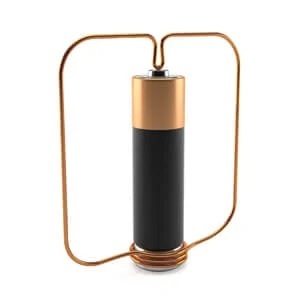Homopolar Motor
Listen to this Article
Homopolar motor with battery and copper wire
The homopolar motor is an electrical motor that operates using the principle of the Lorentz force, which states that a charged particle moving through a magnetic field will experience a force perpendicular to both the direction of motion and the direction of the magnetic field. The homopolar motor was first demonstrated by Michael Faraday in 1821 and is one of the simplest electric motors to construct and operate.
The design of a homopolar motor is relatively straightforward. It consists of a single wire conductor that is free to rotate around a central axis, with a magnetic field provided by a permanent magnet. The wire is connected to a battery or other power source, creating an electrical current through the wire. The Lorentz force created by the interaction of the magnetic field and the current in the wire causes the wire to rotate around the central axis.
The homopolar motor operates on the principle that the magnetic field produced by the current in the wire interacts with the magnetic field of the permanent magnet, causing a torque that drives the wire to rotate. The direction of rotation is determined by the direction of the current flow, the direction of the magnetic field, and the orientation of the wire with respect to the magnetic field.
One of the most notable features of the homopolar motor is that it is a direct current (DC) motor, meaning that the direction of current flow is constant. This is in contrast to alternating current (AC) motors, where the direction of current flow alternates periodically. The homopolar motor also has a very low power output compared to other types of electric motors, making it more of a curiosity than a practical machine.
Despite its simplicity and low power output, the homopolar motor has found several interesting applications in science and engineering. For example, it has been used in experiments to study the interaction of electric and magnetic fields and in the design of high-energy particle accelerators. It has also been used in small-scale models and toys, where its unique motion and simplicity make it an intriguing display of scientific principles.
The homopolar motor is a simple and intriguing device that operates on the principles of electromagnetism. Although it has limited practical applications, it remains an important part of the history of electrical engineering and a testament to the power of scientific curiosity and experimentation.

